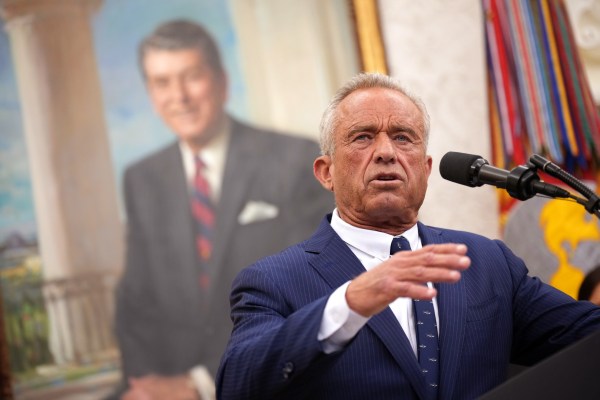Hi and happy Sunday.
We Dispatchers spend a lot of time thinking and writing about how much of what we’ve seen in the public square over the last 10 years is tied to things like media consumption and participation in community life—both at the local and national levels. Living more of our lives mediated through devices doesn’t just affect civil life; it affects our religious life too.
That’s the main argument of pastor and writer Brad Edwards in today’s Dispatch Faith. Living for the “digital crowd,” as he calls it, changes how we relate to institutions as old as the church. And our local churches. But he proposes an antidote.
After Brad’s essay, I also have another “Quick Questions” interview with religious freedom advocate Nadie Maenza on what to make of President Donald Trump’s meeting with Syria’s new president and the religious liberty possibilities latent in Pope Leo XIV’s pontificate.
Brad Edwards: The Empty Ecstasy of Digital Crowds

Should Christians support Black Lives Matter? Fifteen years ago that question would likely have been asked in good faith by a Christian in my congregation. But when someone in our church texted that question to me in early 2017, it had long since become a litmus test.
I wasn’t the only pastor to notice that sometime around 2014, church visitors and members alike began opting into or out of a church based on cultural and political alignment. That trend only accelerated during the pandemic. Many pastors, myself included, missed the significance of that shift because the early signs were still downstream of long-standing theological differences among Christian traditions (e.g., women serving as ordained clergy). But by 2020, alignment with socio-cultural positions became such an overwhelming priority for the typical churchgoer that agreement with theological principles became an afterthought.
This is just one of the clearer symptoms of a deeper shift in the American psyche. We’re in the midst of a fundamental change not only in what we view as ultimately important, but also from where we derive meaning. In an April 2024 article in The Atlantic, “The True Cost of the Churchgoing Bust,” Derek Thompson traces that shift to the widespread abandonment of religious institutions (emphasis added):
Finding meaning in the world is hard too; it’s especially difficult if the oldest systems of meaning-making hold less and less appeal. It took decades for Americans to lose religion. It might take decades to understand the entirety of what we lost.
More than any other change upstream, the “dechurching” of 40 million people over the last 25 years has severed society from long-standing sources of meaning. The culture wars have escalated from a mere conflict between divergent worldviews into an existential crusade for meaning. And as I have written in my recently released book The Reason for Church, these symptoms will continue until we deal with the root of what ails us: exchanging “durable forms of our common life” for disembodied counterfeits of historically proven sources of meaning.
Where institutions (e.g., a local church) provide meaning through shared purpose and belonging, these “digital crowds” promise meaning through easy belonging and affirmation. But because their meaning and belonging are both digital and conditional, neither are durable or transcendent.
Digital crowds promise easy belonging.
The late, beloved Christian pastor and author Eugene Peterson wrote in The Pastor that there are historically three ways we glean religious meaning apart from God: “Through the ecstasy of alcohol and drugs, through the ecstasy of recreational sex, and through the ecstasy of crowds.” You don’t have to be a stage performer to understand why crowds can be dangerously seductive. Crowds are easy. They offer affirmation without vulnerability, attention without sacrifice. The only responsibility incurred in “belonging” to a crowd is reciprocating attention: You have to give it to get it. No one joins a crowd to be challenged or constrained, only affirmed and validated. Nothing is asked of anyone that they don’t already want to give.
Once upon a time, crowds were the least common or accessible of Peterson’s three ecstasies, but smartphones have given us 24/7 access to a digital ecosystem populated with a crowd for every opinion, no matter how trivial or obscure. The exponential growth of the “attention economy” has likewise multiplied, making the influence and affirmation previously enjoyed by entertainers and politicians available to anyone and everyone.
But at what social and spiritual cost?
Like that of drugs, alcohol, and recreational sex, the ecstasy of digital crowds is ultimately dehumanizing. If the ecstasy of even non-digital crowds, as Peterson warns, “destroys the spirit as thoroughly as excessive drink and depersonalized sex,” their digital counterparts may be even more corrosive to the soul. Their easy belonging slowly disenchants our experience of embodied belonging. In search of our next “hit,” we’re unlikely to even notice that we’re becoming radicalized by ever-more-extreme crowds. The more we indulge the temptation of easy belonging, the more we’re inoculated to the discomfort of belonging to anyone.
What do I mean by that? It wasn’t long after our church resumed weekly worship in the wake of pandemic lockdowns that I realized that we couldn’t resume anything if we didn’t regather first. After months of working remotely and socializing digitally, our relational muscles had atrophied. We had all become so accustomed to the easy belonging found online and via screens. As one leader on our team remarked, we had to teach people how to people again. More than basic social skills were at stake—nothing less than meaning itself was on the line. Meaning derived from belonging to someone—even if only in the moment—becomes more elusive the more that “internet brain” handicaps our social capacity. The ease of online connection makes otherwise effortless habits like small talk, or even eye contact, feel less tolerable in person. If you extrapolate this digital conditioning of interpersonal relationships to our relationship with institutions, it’s no wonder churchgoing might “hold less and less appeal.”
And now thanks to social media, we can do more than join digital crowds; we can build our own: So long as we frame our plight with the right emotional appeal, there will always be someone somewhere willing to link digital arms to further our interests. And whether our cause is universal or niche, algorithms incentivize outrage and affirmation to maximize engagement. These perverse incentives ensure every cause is framed as negatively as possible.
Algorithmic anti-vision.
While the “crowds” Peterson warned about were typically gathered for purely positive reasons (e.g. a concert or a football game), they can also often form in response to real problems. Healthy social and spiritual institutions can serve to channel our disappointment and frustration to improve the world around us. At their best, they provide meaning-full opportunities to solve problems we can’t solve on our own—especially those most urgent. But when institutions aren’t healthy, crowds can incentivize reform and hold institutions accountable.
Crowds and institutions can exist in a symbiotic relationship with each other. In a free society, institutions need prophetic voices to resist stagnation and fulfill their purpose. Crowds need institutional systems to implement and scale the solutions they were formed to advocate for. But as I wrote in The Reason for Church, “social media companies profit most from existential problems going unresolved.” And if the world needs to keep burning for platforms to keep earning, digital crowds will likewise be fueled and perpetuated by crisis. The same algorithms that sort us into digital crowds also weaponize the narcissism of minor differences to monetize our attention. We shouldn’t be surprised if, after steeping in these algorithms for nearly 15 years, we’ve all been shaped and conditioned by anti-vision: deriving meaning from what we’re fighting against rather than what we’re fighting for.
It is anti-vision that invites us to punch Nazis, stop the steal, or force full (UAP) disclosure. Pillaging is the point, not problem-solving. Our social actions look more like populist crusades and less like town hall meetings, and crusades make meaning by making enemies. Burning down our enemies’ institutions is all part of the grand strategy. Blessed by an omniscient algorithm, we’ll never run out of meaning-making opportunities because we’ll never run out of new enemies.
As anti-vision backfills into our souls and reshapes our affections, it becomes a divisive filter for all of our relationships. If we accept that algorithms are being used to exploit political differences and sort us according to anti-vision, why would they not also weaponize gender? We already have evidence of a “growing ideological chasm” between men and women leading to a crisis in dating, but the same chasm is also starting to threaten otherwise stable marriages.
As a pastor, I’m used to helping couples work through the whats and hows of their life together. It’s expected that every marriage struggles with communication, especially early on. But more and more, I’m meeting with couples—many of whom have been married a dozen years or more—who aren’t on the same page regarding the why of daily life. It used to be that a couple’s fundamental values (e.g. parenting, intimacy, work-life balance) and worldview would grow stronger and further integrate over time, but that’s not a safe assumption anymore. As each spouse finds meaning along different algorithmic trajectories (e.g. Instagram vs. X/Twitter), differences in how or what can widen to become as ideological— and irreconcilable—as those between the Democratic National Committee and the GOP. Anti-vision makes starting or sustaining any relationship impossible.
Disembodied escape.
Digital crowds are so tempting because, universally, “[w]e hunger to escape the dullness, the boredom, the tiresomeness of me,” Peterson writes. But escape is a poor substitute for transcendence. A crowd:
takes us out of ourselves, but not to God, only away from him. … We can escape upward or downward. Drugs and depersonalized sex are a false transcendence downward. A crowd is an exercise in false transcendence upward, which is why all crowds are spiritually pretty much the same.
If, as philosopher Marshall McLuhan posited, “the medium is the message,” social media disciples users unto a fusion of expressive individualism and digital gnosticism that comedian Bo Burnham brilliantly (if painfully) articulated in his musical satire, Inside:
All human interaction … should be contained in the much more safe, much more real interior digital space … The outside world, the non-digital world, is merely a theatrical space in which one stages and records content for the much more real, much more vital digital space. One should only engage with the outside world as one engages with a coal mine. Suit up, gather what is needed, and return to the surface.
To explain the potentially harmful consequences of television to media consumers, McLuhan argued that “every augmentation is also an amputation.” Fifty years later, his warning sounds hyperbolic when applied to television but understated in light of how the smartphone has rewired childhood. But matter matters. Any use of digital technology to augment human experience will amputate something of our capacity to both belong and experience meaning in the material world, which only makes our hunger to escape more consuming. Wash. Rinse. Repeat.
The alternative to digital crowds: spiritual greenhouses.
If the first step in any recovery is admitting we have a problem, we need to accept that abandoning institutions and instead seeking the digital crowd has robbed us not only of meaningful connection, but also of our connection to meaning itself. The result is a society that increasingly resembles cut flowers—an organism with the appearance of life but that is nevertheless doomed to wilt. Undoing that damage will require more than quitting crowds cold turkey or embracing our inner Luddite. To inoculate ourselves from the false transcendence, anti-vision, and disembodied escape of digital crowds, we have to also recover the goodness and beauty of institutions.
Thankfully, we already have access to potent spiritual hardware designed for exactly that purpose. The transcendent meaning that we long for—indeed, that we’re made for—lies in the most counter-intuitive, universally cringe, and eagerly abandoned institution of the last 75 years: the local church.
To be fair, we Christians are often guilty of what Peterson so memorably cautioned: We are just as prone to treating our church like another digital crowd—an interchangeable vehicle for meaning with a cross slapped on the front door. For many, “church” has become just one of many ways to escape ourselves, but no church can compete with Silicon Valley on that. Nor should we try. We are made for more than digital crowds.
At their best, churches are spiritual greenhouses for cultivating a fundamentally different way of seeing, living and, therefore, making meaning in the world. They embody the true and better story of humanity—imperfectly, of course, but how else would a story of grace be embodied? For Christians, ultimate meaning is derived from the gospel: the “good news” that God took on flesh and entered into human history not to make enemies or destroy them, but to make his enemies his friends. To rescue us. The more we embody that gospel week-in and week-out, the more we ruin our appetite for anti-vision and the more belonging to others infuses our lives with the gospel’s transcendent meaning.
That said, our hope is ultimately not in a church’s ability to mediate meaning. If all that took was belonging to others, we wouldn’t have any more reason for rechurching than we would for reconnecting to any other institution. The only way belonging to a church can offer us the transcendent meaning we long for is because it is from within and through church that we experience belonging to a transcendent God. This is the universal human need that the first question of the Heidelberg Catechism seeks to address in asking, “What is our only comfort in life or death?” And its answer, “That I am not my own, but belong—body and soul, in life and in death—to my faithful Savior, Jesus Christ,” is only fully apprehended and experienced among the Body and Bride of Christ.
That alone is more than enough reason for church.
Quick Questions
During his Middle East tour last week, President Donald Trump met with interim Syrian President Ahmed al-Sharaa—the former jihadist whose rebel group toppled the Assad regime after years of civil war. The meeting followed the removal of long-standing economic sanctions on Syria and preceded Trump making several requests of al-Sharaa, including signing onto the Abraham Accords and normalizing relations with Israel, evicting Palestinian terrorists from Syria, and standing against an ISIS resurgence.
The meeting may have the effect of further legitimizing al-Sharaa and his government, but given his jihadist roots and the fractures within Syria, only time will tell if al-Sharaa can make good on moving toward more liberal ideals, including religious freedom for Syria’s minority groups. Many of these questions have been apparent from the day al-Sharaa took power, and we’ve covered some of them before in this newsletter.
This week I posed some questions via email to Nadine Maenza, president of the International Religious Freedom Secretariat, global fellow at the Wilson Center, and former chair of the U.S. Commission for International Religious Freedom. (The podcast interview I did with her earlier this year also provides helpful background on the Syria situation.)
My questions to Maenza are below in bold and include a bit about Pope Leo XIV’s address to Vatican diplomats last week.
The question with Ahmed al-Sharaa since he took power has been how much he would respect certain liberal ideals, such as freedom of religion. Does this week’s meeting with President Donald Trump offer any more insight into that question?
While Ahmed al-Sharaa and Hay’at Tahrir al-Sham have been designated as terrorists by the U.S. government and others, many who have engaged with him describe him as a pragmatist. His willingness to respond to direct requests from President Trump—despite the political risk—demonstrates that positive incentives, especially when tied to specific and measurable benchmarks, can be effective in shaping behavior.
Rather than offering support unconditionally, the U.S. and international community should push for concrete actions that improve conditions for all Syrians.
How optimistic are you that al-Sharaa’s government will do some of the things Trump suggested, such as normalizing relations with Israel and kicking out Palestinian terrorists and others?
If al-Sharaa agreed to these requests from President Trump in such a public forum, I would expect him to follow through. But to do so, he needs clear and sustained pressure from the U.S. and international community. Without it, the political cost within his own base may be too high.
Most people don’t realize the intense pressure al-Sharaa faces from his Islamist supporters. While I was in Syria in April, many pointed to a wave of criticism on social media—specifically targeting his wife for wearing bright colors at public events, even though she was modestly dressed and wore a hijab. This kind of backlash reflects the internal constraints he operates under.
External pressure not only increases the likelihood of compliance—it also gives al-Sharaa political cover. It allows him to tell his base that he’s responding to international demands, not unilaterally making concessions.
How do you anticipate Trump’s decision to lift sanctions on Syria will affect religious liberty in Syria?
The dire economic situation in Syria has only deepened sectarian tensions, especially among those returning to destroyed homes and villages, with some finding neighboring communities of other religious or ethnic groups remaining largely intact. Some have warned that the dire economic situation is emboldening extreme voices.
While some believed that maintaining sanctions would preserve leverage for the U.S. and international community to push for an inclusive government and reforms supporting religious freedom, the economic collapse has grown so severe that many now fear widespread starvation. In that context, continuing the sanctions no longer seemed like a viable—or responsible—option.
What would be signs in the next few months that things really are stabilizing in Syria?
First, it is critical to see a sustained decrease in sectarian violence. While the major flashpoints—the mass attacks on Alawite communities in March and Druze communities in April—are behind us, violence continues in these areas. This ongoing instability has had a chilling effect across Syria, where many still hope for peace and security.
A key step is for the interim government to follow President Trump’s directive and remove Islamist foreign fighters, whose presence has fueled unrest. With much of the violence carried out by Syrian Security Forces—largely made up of Hay’at Tahrir al-Sham and Turkish-backed Syrian National Army factions—accountability is essential. Arrests and prosecutions must follow if long-term stability is to be achieved.
Second, it would be encouraging to see real progress in integrating northeast Syria into the Syrian government—so long as it preserves the local governance structures that have fostered some of the region’s strongest religious freedom protections. Done right, this approach can strengthen Damascus while maintaining a cohesive, inclusive society that reflects Syria’s religious and ethnic diversity.
The March 10th agreement between President Ahmed al-Sharaa and SDF Commander Mazloum Abdi was celebrated across the country. Finalizing it would send a powerful message about the potential for inclusive governance.
Pope Leo XIV addressed the Vatican’s diplomatic corps on Friday. How do you anticipate the Vatican’s diplomatic efforts under Pope Leo will be different from those of Pope Francis?
Pope Leo XIV brings a different background and temperament to the role, and I think we can expect a more assertive diplomatic posture from the Vatican under his leadership. I’m encouraged by his early and clear support for religious freedom, which signals a strong commitment to defending fundamental rights from the outset of his pontificate.
Pope Leo’s remarks suggest a focus on moral clarity in global affairs and a readiness to speak out more directly. That could position the Vatican as a stronger voice in regions like the Middle East and Africa, where Christian communities and other religious minorities are facing increasing pressure.
It’s still early, but if Pope Leo uses diplomacy to uphold human dignity and push back against impunity, especially for religious minorities, he could have a profound impact on global religious freedom.
Is there a particular global conflict or issue the Vatican could largely affect that it has not yet?
There’s growing concern about the Vatican’s agreement with the Chinese Communist Party, particularly the role it allows Beijing to play in the selection of Catholic bishops there. Because the terms of their deal have remained largely secret, there’s increasing pressure from the religious freedom community for greater transparency.
If the Chinese government can pressure a global institution as large and historically independent as the Catholic Church, it sets a troubling precedent for how other religious communities may be treated. By asserting its own independence in this matter, the Vatican would not only strengthen its moral authority—it would also send a powerful message on behalf of all religious communities facing state interference.
Another Sunday Read
For the Christian journal Mere Orthodoxy, historian Daniel K. Williams responds to our friend David French’s recent questions about the foundations of the Christian right. Williams traces the evolution of the movement from its “Sunbelt conservatism” focus on policy and support of figures like Dwight Eisenhower and Ronald Reagan to its eventual MAGA-fication. “With evangelicals in both the Sunbelt and the northern Midwest voting Republican by the early 1970s, the evangelical conversion to the GOP was already well underway years before Falwell created the Moral Majority. More than 80 percent of white evangelical voters cast their ballots for Nixon in 1972. But Falwell and some of the other Sunbelt evangelicals who launched the Christian Right in the late 1970s wanted more than merely the election of Republicans. They wanted to fight both the sexual revolution and the secularization of the nation – or, in their words, ‘take back America” from the liberals they accused of destroying its Christian values.’” The Christian right of today has come to value a different strategy, Williams contends. “But such transactional arrangements alone could not explain the enthusiasm that many evangelicals felt toward Trump. What can explain it, I think, is that the center of evangelical conservatism had shifted from the Sunbelt to the rural South – just as a half-century earlier, it had shifted away from the Midwest. Rural southern evangelicals picked up on the culture-war language of their Sunbelt counterparts who had launched the Christian Right in the 1970s, and they retained the dream of an evangelical take-over of governmental institutions, but this time, they melded it not with the politics of upward mobility, free enterprise, and Reagan-style optimism, but with the politics of grievance and defensiveness. They believed that their own way of life was under attack – and this time, they were determined to defend themselves not restoring the values of the Eisenhower era but by engaging in a much more sweeping attack on the establishment. For this latest version of evangelical culture warriors, what matters most is not policy but identity.”
Religion in an Image










Please note that we at The Dispatch hold ourselves, our work, and our commenters to a higher standard than other places on the internet. We welcome comments that foster genuine debate or discussion—including comments critical of us or our work—but responses that include ad hominem attacks on fellow Dispatch members or are intended to stoke fear and anger may be moderated.
With your membership, you only have the ability to comment on The Morning Dispatch articles. Consider upgrading to join the conversation everywhere.